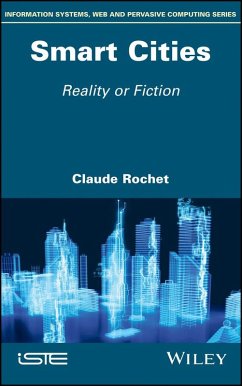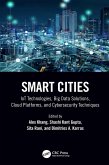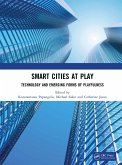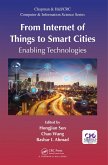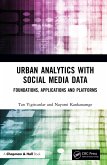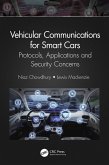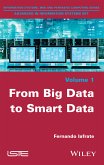139,99 €
139,99 €
inkl. MwSt.
Sofort per Download lieferbar

0 °P sammeln
139,99 €
Als Download kaufen

139,99 €
inkl. MwSt.
Sofort per Download lieferbar

0 °P sammeln
Jetzt verschenken
Alle Infos zum eBook verschenken
139,99 €
inkl. MwSt.
Sofort per Download lieferbar
Alle Infos zum eBook verschenken

0 °P sammeln
- Format: ePub
- Merkliste
- Auf die Merkliste
- Bewerten Bewerten
- Teilen
- Produkt teilen
- Produkterinnerung
- Produkterinnerung

Bitte loggen Sie sich zunächst in Ihr Kundenkonto ein oder registrieren Sie sich bei
bücher.de, um das eBook-Abo tolino select nutzen zu können.
Hier können Sie sich einloggen
Hier können Sie sich einloggen
Sie sind bereits eingeloggt. Klicken Sie auf 2. tolino select Abo, um fortzufahren.

Bitte loggen Sie sich zunächst in Ihr Kundenkonto ein oder registrieren Sie sich bei bücher.de, um das eBook-Abo tolino select nutzen zu können.
The intelligence of a city is the capacity to learn: to learn the past, its history and the culture of its territory. Unlike the smart city, we do not build a city from scratch and there is nothing, there is no smart city standard car intelligence is measured this ability to fit into a territorial dynamic, a story and a culture. Continuous learning through instantaneous feedback provides the digital to understand and map the urban system and driver.
- Geräte: eReader
- mit Kopierschutz
- eBook Hilfe
- Größe: 3.31MB
Andere Kunden interessierten sich auch für
![Smart Cities (eBook, ePUB) Smart Cities (eBook, ePUB)]() Smart Cities (eBook, ePUB)52,95 €
Smart Cities (eBook, ePUB)52,95 €![Smart Cities For Dummies (eBook, ePUB) Smart Cities For Dummies (eBook, ePUB)]() Jonathan ReichentalSmart Cities For Dummies (eBook, ePUB)22,99 €
Jonathan ReichentalSmart Cities For Dummies (eBook, ePUB)22,99 €![Smart Cities at Play: Technology and Emerging Forms of Playfulness (eBook, ePUB) Smart Cities at Play: Technology and Emerging Forms of Playfulness (eBook, ePUB)]() Smart Cities at Play: Technology and Emerging Forms of Playfulness (eBook, ePUB)52,95 €
Smart Cities at Play: Technology and Emerging Forms of Playfulness (eBook, ePUB)52,95 €![From Internet of Things to Smart Cities (eBook, ePUB) From Internet of Things to Smart Cities (eBook, ePUB)]() From Internet of Things to Smart Cities (eBook, ePUB)46,95 €
From Internet of Things to Smart Cities (eBook, ePUB)46,95 €![Urban Analytics with Social Media Data (eBook, ePUB) Urban Analytics with Social Media Data (eBook, ePUB)]() Tan YigitcanlarUrban Analytics with Social Media Data (eBook, ePUB)45,95 €
Tan YigitcanlarUrban Analytics with Social Media Data (eBook, ePUB)45,95 €![Vehicular Communications for Smart Cars (eBook, ePUB) Vehicular Communications for Smart Cars (eBook, ePUB)]() Niaz ChowdhuryVehicular Communications for Smart Cars (eBook, ePUB)43,95 €
Niaz ChowdhuryVehicular Communications for Smart Cars (eBook, ePUB)43,95 €![From Big Data to Smart Data (eBook, ePUB) From Big Data to Smart Data (eBook, ePUB)]() Fernando IafrateFrom Big Data to Smart Data (eBook, ePUB)139,99 €
Fernando IafrateFrom Big Data to Smart Data (eBook, ePUB)139,99 €-
-
-
The intelligence of a city is the capacity to learn: to learn the past, its history and the culture of its territory. Unlike the smart city, we do not build a city from scratch and there is nothing, there is no smart city standard car intelligence is measured this ability to fit into a territorial dynamic, a story and a culture. Continuous learning through instantaneous feedback provides the digital to understand and map the urban system and driver.
Dieser Download kann aus rechtlichen Gründen nur mit Rechnungsadresse in A, B, BG, CY, CZ, D, DK, EW, E, FIN, F, GR, HR, H, IRL, I, LT, L, LR, M, NL, PL, P, R, S, SLO, SK ausgeliefert werden.
Produktdetails
- Produktdetails
- Verlag: American Counseling Association
- Seitenzahl: 240
- Erscheinungstermin: 21. August 2018
- Englisch
- ISBN-13: 9781119550976
- Artikelnr.: 53708156
- Verlag: American Counseling Association
- Seitenzahl: 240
- Erscheinungstermin: 21. August 2018
- Englisch
- ISBN-13: 9781119550976
- Artikelnr.: 53708156
- Herstellerkennzeichnung Die Herstellerinformationen sind derzeit nicht verfügbar.
Claude Rochet, Professeur Honoraire des Universités, Chercheur à l'Université de Versailles St Quentin (Paris Saclay), France.
Foreword ix
Introduction xv
Chapter 1. What Do We Mean by "Smart City" and Where Does This Idea Come
From? 1
1.1. Not-so-smart smart cities! 3
1.2. The smoke and mirrors of smart cities 6
1.3. Other mirrors for other smoke: cities of the creative classes 12
1.4. So what is a "smart city"? 17
Chapter 2. The Challenges of Urban Development in the Context of the Third
Industrial Revolution 21
2.1. The demographic and economic challenges: toward a change in economic
model 21
2.2. Geopolitical challenges: the polar shift in development in favor of
the south-west and the different strategies among industrialized and
emerging countries 26
2.3. Energy transfer: the fossil fuel curse is not about to disappear.33
2.4. The six breakthroughs in urban development based on smart cities 37
Chapter 3. What Makes a City Smart? 43
3.1. Lessons from medieval cities 44
3.1.1. Architect-less cities? 45
3.1.2. How do cities become unintelligent? 49
3.2.A city is a system of life 52
3.3.Smart territory 54
3.3.1.Territory: an immaterial asset 54
3.3.2.The territory secretes innovation (and not the other way around) 58
3.3.3.The territorial dynamic in action 60
3.4.Are metropolises smart territories? 63
3.5.A city is not a collection of smarties 65
3.5.1.A city is a living system 65
3.5.2 which we understand today through new approaches 66
3.5.3 at the heart of which the sciences of complexity 67
3.5.4.help conjugate internal semi-stability and external instability 68
3.6.The dangers of a technocentric approach 70
Chapter 4. New Sciences of Cities 73
4.1.The more or less sympathetic myths of the ideal city 75
4.2.A city is an imbalanced system 79
4.2.1.Definition of an urban ecosystem 80
4.2.2.A city is a system in incomplete equilibrium 82
4.2.3.What is a city's optimal size? 85
4.2.4.Size and inequalities are correlated 86
4.3.Smart city: an autopoietic system 89
4.4.A city must be designed as a "system of systems" 95
4.4.1.Modeling 99
4.4.2.Emergence 103
4.4.3.Evolution inside: the urban lifecycle management 105
4.4.4.System architecture as a frame of representation 107
4.4.5.The design method 109
4.4.6.Integration process: more efficiency for less 114
4.4.7.Integrating heterogeneous systems 118
Chapter 5. Smart City in Action 125
5.1.Two cities that should not exist: Norilsk and Singapore 125
5.1.1.Norilsk, the most polluted and polluting city in the world 125
5.1.2.Singapore, the smart nation 127
5.2.Pilot projects 133
5.2.1.The African city 134
5.2.2.The emergence of a territorial project through meaning: the case of
Rhamna, in Morocco 136
5.2.3.Casablanca as a prototype for remedying to the tentacular growth of
cities 141
5.2.4.Angola, Namibia: eco-design of a drinking water supply 146
5.2.5.Urban problem and economic transition: the Russian case of monotowns
153
5.3.The worksites of the smart city 159
5.3.1.The power of data 159
5.3.2.How much do smart cities cost? 171
5.3.3.The government of a smart city 179
5.3.4.What are the tasks and what is the form of a smart government for a
smart city? 180
Conclusion 187
References 191
Index 203
Introduction xv
Chapter 1. What Do We Mean by "Smart City" and Where Does This Idea Come
From? 1
1.1. Not-so-smart smart cities! 3
1.2. The smoke and mirrors of smart cities 6
1.3. Other mirrors for other smoke: cities of the creative classes 12
1.4. So what is a "smart city"? 17
Chapter 2. The Challenges of Urban Development in the Context of the Third
Industrial Revolution 21
2.1. The demographic and economic challenges: toward a change in economic
model 21
2.2. Geopolitical challenges: the polar shift in development in favor of
the south-west and the different strategies among industrialized and
emerging countries 26
2.3. Energy transfer: the fossil fuel curse is not about to disappear.33
2.4. The six breakthroughs in urban development based on smart cities 37
Chapter 3. What Makes a City Smart? 43
3.1. Lessons from medieval cities 44
3.1.1. Architect-less cities? 45
3.1.2. How do cities become unintelligent? 49
3.2.A city is a system of life 52
3.3.Smart territory 54
3.3.1.Territory: an immaterial asset 54
3.3.2.The territory secretes innovation (and not the other way around) 58
3.3.3.The territorial dynamic in action 60
3.4.Are metropolises smart territories? 63
3.5.A city is not a collection of smarties 65
3.5.1.A city is a living system 65
3.5.2 which we understand today through new approaches 66
3.5.3 at the heart of which the sciences of complexity 67
3.5.4.help conjugate internal semi-stability and external instability 68
3.6.The dangers of a technocentric approach 70
Chapter 4. New Sciences of Cities 73
4.1.The more or less sympathetic myths of the ideal city 75
4.2.A city is an imbalanced system 79
4.2.1.Definition of an urban ecosystem 80
4.2.2.A city is a system in incomplete equilibrium 82
4.2.3.What is a city's optimal size? 85
4.2.4.Size and inequalities are correlated 86
4.3.Smart city: an autopoietic system 89
4.4.A city must be designed as a "system of systems" 95
4.4.1.Modeling 99
4.4.2.Emergence 103
4.4.3.Evolution inside: the urban lifecycle management 105
4.4.4.System architecture as a frame of representation 107
4.4.5.The design method 109
4.4.6.Integration process: more efficiency for less 114
4.4.7.Integrating heterogeneous systems 118
Chapter 5. Smart City in Action 125
5.1.Two cities that should not exist: Norilsk and Singapore 125
5.1.1.Norilsk, the most polluted and polluting city in the world 125
5.1.2.Singapore, the smart nation 127
5.2.Pilot projects 133
5.2.1.The African city 134
5.2.2.The emergence of a territorial project through meaning: the case of
Rhamna, in Morocco 136
5.2.3.Casablanca as a prototype for remedying to the tentacular growth of
cities 141
5.2.4.Angola, Namibia: eco-design of a drinking water supply 146
5.2.5.Urban problem and economic transition: the Russian case of monotowns
153
5.3.The worksites of the smart city 159
5.3.1.The power of data 159
5.3.2.How much do smart cities cost? 171
5.3.3.The government of a smart city 179
5.3.4.What are the tasks and what is the form of a smart government for a
smart city? 180
Conclusion 187
References 191
Index 203
Foreword ix
Introduction xv
Chapter 1. What Do We Mean by "Smart City" and Where Does This Idea Come
From? 1
1.1. Not-so-smart smart cities! 3
1.2. The smoke and mirrors of smart cities 6
1.3. Other mirrors for other smoke: cities of the creative classes 12
1.4. So what is a "smart city"? 17
Chapter 2. The Challenges of Urban Development in the Context of the Third
Industrial Revolution 21
2.1. The demographic and economic challenges: toward a change in economic
model 21
2.2. Geopolitical challenges: the polar shift in development in favor of
the south-west and the different strategies among industrialized and
emerging countries 26
2.3. Energy transfer: the fossil fuel curse is not about to disappear.33
2.4. The six breakthroughs in urban development based on smart cities 37
Chapter 3. What Makes a City Smart? 43
3.1. Lessons from medieval cities 44
3.1.1. Architect-less cities? 45
3.1.2. How do cities become unintelligent? 49
3.2.A city is a system of life 52
3.3.Smart territory 54
3.3.1.Territory: an immaterial asset 54
3.3.2.The territory secretes innovation (and not the other way around) 58
3.3.3.The territorial dynamic in action 60
3.4.Are metropolises smart territories? 63
3.5.A city is not a collection of smarties 65
3.5.1.A city is a living system 65
3.5.2 which we understand today through new approaches 66
3.5.3 at the heart of which the sciences of complexity 67
3.5.4.help conjugate internal semi-stability and external instability 68
3.6.The dangers of a technocentric approach 70
Chapter 4. New Sciences of Cities 73
4.1.The more or less sympathetic myths of the ideal city 75
4.2.A city is an imbalanced system 79
4.2.1.Definition of an urban ecosystem 80
4.2.2.A city is a system in incomplete equilibrium 82
4.2.3.What is a city's optimal size? 85
4.2.4.Size and inequalities are correlated 86
4.3.Smart city: an autopoietic system 89
4.4.A city must be designed as a "system of systems" 95
4.4.1.Modeling 99
4.4.2.Emergence 103
4.4.3.Evolution inside: the urban lifecycle management 105
4.4.4.System architecture as a frame of representation 107
4.4.5.The design method 109
4.4.6.Integration process: more efficiency for less 114
4.4.7.Integrating heterogeneous systems 118
Chapter 5. Smart City in Action 125
5.1.Two cities that should not exist: Norilsk and Singapore 125
5.1.1.Norilsk, the most polluted and polluting city in the world 125
5.1.2.Singapore, the smart nation 127
5.2.Pilot projects 133
5.2.1.The African city 134
5.2.2.The emergence of a territorial project through meaning: the case of
Rhamna, in Morocco 136
5.2.3.Casablanca as a prototype for remedying to the tentacular growth of
cities 141
5.2.4.Angola, Namibia: eco-design of a drinking water supply 146
5.2.5.Urban problem and economic transition: the Russian case of monotowns
153
5.3.The worksites of the smart city 159
5.3.1.The power of data 159
5.3.2.How much do smart cities cost? 171
5.3.3.The government of a smart city 179
5.3.4.What are the tasks and what is the form of a smart government for a
smart city? 180
Conclusion 187
References 191
Index 203
Introduction xv
Chapter 1. What Do We Mean by "Smart City" and Where Does This Idea Come
From? 1
1.1. Not-so-smart smart cities! 3
1.2. The smoke and mirrors of smart cities 6
1.3. Other mirrors for other smoke: cities of the creative classes 12
1.4. So what is a "smart city"? 17
Chapter 2. The Challenges of Urban Development in the Context of the Third
Industrial Revolution 21
2.1. The demographic and economic challenges: toward a change in economic
model 21
2.2. Geopolitical challenges: the polar shift in development in favor of
the south-west and the different strategies among industrialized and
emerging countries 26
2.3. Energy transfer: the fossil fuel curse is not about to disappear.33
2.4. The six breakthroughs in urban development based on smart cities 37
Chapter 3. What Makes a City Smart? 43
3.1. Lessons from medieval cities 44
3.1.1. Architect-less cities? 45
3.1.2. How do cities become unintelligent? 49
3.2.A city is a system of life 52
3.3.Smart territory 54
3.3.1.Territory: an immaterial asset 54
3.3.2.The territory secretes innovation (and not the other way around) 58
3.3.3.The territorial dynamic in action 60
3.4.Are metropolises smart territories? 63
3.5.A city is not a collection of smarties 65
3.5.1.A city is a living system 65
3.5.2 which we understand today through new approaches 66
3.5.3 at the heart of which the sciences of complexity 67
3.5.4.help conjugate internal semi-stability and external instability 68
3.6.The dangers of a technocentric approach 70
Chapter 4. New Sciences of Cities 73
4.1.The more or less sympathetic myths of the ideal city 75
4.2.A city is an imbalanced system 79
4.2.1.Definition of an urban ecosystem 80
4.2.2.A city is a system in incomplete equilibrium 82
4.2.3.What is a city's optimal size? 85
4.2.4.Size and inequalities are correlated 86
4.3.Smart city: an autopoietic system 89
4.4.A city must be designed as a "system of systems" 95
4.4.1.Modeling 99
4.4.2.Emergence 103
4.4.3.Evolution inside: the urban lifecycle management 105
4.4.4.System architecture as a frame of representation 107
4.4.5.The design method 109
4.4.6.Integration process: more efficiency for less 114
4.4.7.Integrating heterogeneous systems 118
Chapter 5. Smart City in Action 125
5.1.Two cities that should not exist: Norilsk and Singapore 125
5.1.1.Norilsk, the most polluted and polluting city in the world 125
5.1.2.Singapore, the smart nation 127
5.2.Pilot projects 133
5.2.1.The African city 134
5.2.2.The emergence of a territorial project through meaning: the case of
Rhamna, in Morocco 136
5.2.3.Casablanca as a prototype for remedying to the tentacular growth of
cities 141
5.2.4.Angola, Namibia: eco-design of a drinking water supply 146
5.2.5.Urban problem and economic transition: the Russian case of monotowns
153
5.3.The worksites of the smart city 159
5.3.1.The power of data 159
5.3.2.How much do smart cities cost? 171
5.3.3.The government of a smart city 179
5.3.4.What are the tasks and what is the form of a smart government for a
smart city? 180
Conclusion 187
References 191
Index 203
